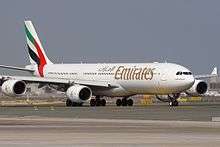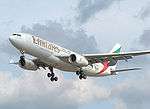Emirates Flight 407
Emirates Flight 407 was a scheduled international passenger flight operated by Emirates from Melbourne to Dubai, using an Airbus A340-500 aircraft. On 20 March 2009, the flight failed to take off properly at Melbourne Airport, hitting several structures at the end of the runway before eventually climbing enough to return to the airport for a safe landing. Although no fatalities or injuries resulted, damage to the aircraft was severe enough for the event to be classified by Australian Transport Safety Bureau as an "accident". It has been described "as close as we have ever come to a major aviation catastrophe in Australia" by aviation officials.[1]
 A6-ERG, the aircraft involved, seen at Dubai International Airport in 2008. | |
| Accident | |
|---|---|
| Date | 20 March 2009 |
| Summary | Tailstrike on takeoff and runway overrun due to pilot error |
| Site | Melbourne Airport, Melbourne, Australia 37°40′14″S 144°50′17″E |
| Aircraft | |
| Aircraft type | Airbus A340-541 |
| Operator | Emirates |
| Registration | A6-ERG |
| Flight origin | Auckland Airport, Auckland, New Zealand |
| Stopover | Melbourne Airport Melbourne, Australia |
| Destination | Dubai International Airport, Dubai, United Arab Emirates |
| Passengers | 257 |
| Crew | 18 |
| Fatalities | 0 |
| Injuries | 0 |
| Survivors | 275 |
Chronology
The scheduled flight departed from Melbourne as planned at 22:30 using the 3,657-metre-long (11,998 ft) Runway 16. The captain ordered the first officer to rotate 1,043 m (3,422 ft) before the end of the runway, travelling at a speed of 270 km/h (168 mph).[2] As the aircraft pitched upward it failed to leave the ground and the tail section struck and continued to scrape along the runway. The captain took over the controls and applied maximum thrust on all four engines by using the Take-off/Go-around (TOGA) detent.[3][4][5] After exhausting the entire length of the runway, the aircraft failed to become airborne, and did not leave the ground until 148 m (486 ft) beyond the end of the runway.[6] The captain later said "I thought we were going to die. It was that close".[3][4]
Subsequently, the aircraft hit a strobe light at the end of the runway[7] and continued to climb with difficulties. At 350 m (1,148 ft) beyond the end of the runway, the landing gear hit and damaged the 1.8-metre-high (6 ft) localiser antenna array. At 500 m (1,640 ft) beyond the end of the runway, the aircraft barely missed the 2.24-metre-tall (7 ft) airport perimeter fence.
The aircraft eventually climbed away over Port Phillip Bay. The first officer then reviewed the take-off performance calculations in his electronic flight bag, and discovered that he had understated the aircraft's weight by 100 tonnes (262.9 tonnes instead of 362.9).[3][5][8][9][10] This meant that an incorrect flex temp was applied, which had resulted in a lower than necessary engine thrust and consequently insufficient acceleration and airspeed.[5]
The pilots finished dumping fuel over the bay by 23:27, and they subsequently received a report of smoke in the cabin. They requested an immediate return, which ATC granted, and they returned to the airport at 23:36 without further incident.[5]
Aircraft damage and repair
Despite having tailstrike protection built into the A340-500, the rear pressure bulkhead and the underlying structure were severely damaged during the take-off roll when the tail struck the runway with considerable force. The aircraft also suffered extensive damage to the bottom of the fuselage as it scraped along the runway, a large surface having been completely stripped of its external sheet.[11] During the investigation, it was discovered that the jet had experienced at least one but possibly three or more tail strikes during previous take-off rolls.
The aircraft was not written off, but was instead returned to Airbus by way of a low altitude flight without pressurisation routed from Melbourne to Toulouse on 19 June via Perth, Singapore, Dubai and Cairo with the crew flying below 12,000 feet (3,700 m).[12]
The aircraft made its first revenue flight after repairs on 1 December 2009 as flight EK424 and remained in service operating short to medium haul international flights out of Dubai, until it was withdrawn from service in October 2014. It was scrapped later that year.[13][14]
Aircrew
After being interviewed by investigators, the two pilots of the flight returned to Dubai. The captain and the first officer were asked to resign from Emirates upon their arrival in Dubai, and both did so.[15]
The captain of Flight 407 had slept for only six hours during the twenty-four hours before the accident, while the first officer had eight hours sleep in the same period.[16][lower-alpha 1] The captain had flown a total 99 hours during the prior month, one hour short of the maximum 100 flying hours allowed by Emirates, while the first officer had flown 90 hours in the same period.[3][4][17][18]
Investigation
The accident investigation was performed by the Australian Transport Safety Bureau (ATSB). Central to the investigation was how the first officer had come to use the wrong aircraft weight, why that mistake was not picked up before takeoff, and why the flight crew had not realized the acceleration was much slower than expected until nearly entirely exhausting the 3 km/2 mi runway.[19]
Studies were also carried out that showed that aircrew could have difficulty recognising that incorrect data had been entered in avionic equipment resulting in poor take-off performance. The ATSB issued a safety recommendation to the United States Federal Aviation Administration and a safety advisory notice to the International Air Transport Association and the Flight Safety Foundation. In addition Airbus investigated the development of software to help pilots recognise unusual or poor performance on take-off.[20]
In October 2011, the ATSB released the findings of their investigation into the incident. They found that human error was the cause, and urged the development of technological aids that would alert pilots to incorrect data entry or insufficient take-off speed.[21]
In response to the incident, Emirates reviewed its pre-flight procedures, mandating the duplication of laptop computers used for pre-flight planning so as to ensure dual data entry. They are also developing an avionics system for take-off acceleration-monitoring and alerting. Airbus updated its software to detect erroneous data. In October 2011, they announced plans to include a software program to calculate the required runway length. Furthermore, Airbus is developing a monitoring system to compute required acceleration rates and apply a "reasonableness test" to data input and alert the pilot to any potential errors. The system could potentially be certified by 2015.[21][22]
Similar events
- On 22 May 2015, an Air France Boeing 777 operating cargo flight AF-6724 from Paris to Mexico City was involved in a serious incident when both captain and first officer independently entered an erroneous weight value of 243 tons rather than 343 tons into their electronic flight bags. The erroneously calculated performance data was subsequently entered into the flight management system. When the aircraft failed to lift-off at the calculated speed, maximum (TOGA) power was applied and the aircraft became airborne and continued without further incident to its destination. The automatic tail-strike prevention system activated to prevent pitch increasing to a level which would cause a tail strike.[23]
- On 15 September 2015, Qatar Airways Flight 778, a Boeing 777-300ER registered A7-BAC, struck several approach lights immediately following takeoff from Miami on its way to Doha, tearing a 46-centimetre (18 in) gash in the fuselage behind the rear cargo door. The flight continued on without incident for the remainder of the 13.5-hour flight duration. The pilots had mistakenly taken off from intersection T1 on runway 09, using only 2,600 m (8,500 ft) of the full 3,968 m (13,018 ft) runway length, after misreading information printed on their Electronic Flight Bag.[24]
- On 21 July 2017, a Sunwing Boeing 737 operating Thomson Airways flight BY-1526 with six crew and 179 passengers on board struck a runway approach light immediately after takeoff from Belfast at the start of its flight to Corfu. The pilots had entered an incorrect outside air temperature into the aircraft's Flight Management Computer, which caused it to use a lower thrust setting than required (81% N1, instead of 93%).[25]
Notes
- It was incorrectly reported in the Sunday Herald Sun that one of the pilots had slept only three and a half hours
See also
References
- "Emirates jet close to major 'aviation disaster'". Australian Associated Press. 12 April 2009. Retrieved 26 January 2011.
- Australian Transport Safety Bureau. ATSB Transport Safety Report AO-2009-012 FINAL. 16 December 2011. Viewed 24 Dec 2013.
- Stewart, Cameron (12 September 2009). "The devil is in the data". The Australian. Retrieved 26 January 2011.
- Ellen Whinnett Emirates pilot in tail strike near-disaster tells his story Herald Sun 12 July 2009
- Australian Transport Safety Bureau. ATSB Interim report AO-2009-012. 18 December 2009. Viewed 20 Dec 2009.
- Final report p.9
- Final report p.11
- Whinnett, Ellen (26 April 2009). "Pilot of Emirates flight that nearly crashed at Melbourne Airport was sleep-deprived". Sunday Herald Sun. Archived from the original on 30 April 2009. Retrieved 27 January 2011.
- Tail Strike – Melbourne Airport, Vic. – 20 March 2009 – A6-ERG – Airbus A340-500 (PDF). ATSB Transport Safety Report. 30 April 2009. ISBN 978-1-921602-43-6. AO-2009-012. Retrieved 27 January 2011.
- Final report p.3
- Final report, pp.4-8
- "Aviation Photo Gallery". MyAviation.net. 22 June 2009. Archived from the original on 23 March 2012. Retrieved 26 January 2011.
- "A6-ERG Airbus A340-541 (MSN 608) of Emirates". Retrieved 5 April 2018.
- "A6-ERG Airbus A340-541 (MSN 608) of Emirates". Retrieved 5 April 2018.
- "225 Are 'Lucky To Be Alive'". 12 April 2009. Archived from the original on 13 April 2009.
- Final report p.18
- Creedy, Steve (1 May 2009). "Close call as bungle left jet struggling for lift". The Australian. Retrieved 26 January 2011.
- Final report pp.13-14
- Final report, p.ix
- "Tailstrike and runway overrun – Airbus A340-541, A6-ERG, Melbourne Airport, Victoria, 20 March 2009". 12 October 2012. Retrieved 23 January 2012.
- Steve Creedy (18 December 2011). "Airline's close-call to make flying safer". The Australian. Retrieved 13 January 2012.
- Andrew Heasley (16 December 2011). "Typo blamed for Emirates jet's botched take-off". The Sydney Morning Herald. Retrieved 13 January 2012.
- Hradecky, Simon. "Incident: Air France B772 at Paris on May 22nd 2015, 100 tons missing in inserted takeoff weight". The Aviation Herald. Retrieved 7 February 2019.
- Hradecky, Simon. "Accident: Qatar B773 at Miami on Sep 15th 2015, overran runway on takeoff run and struck approach lights on departure". The Aviation Herald. Retrieved 7 April 2018.
- "AAIB Special Bulletin S2/2017" (PDF). AAIB. 19 September 2017. Retrieved 11 January 2018.
External links
Australian Transport Safety Bureau Aviation Occurrence Investigation AO-2009-012 "Tailstrike and runway overrun - Airbus A340-541, A6-ERG, Melbourne Airport, Victoria, 20 March 2009"
- "Summary". Retrieved 9 September 2016.
- "Preliminary Report" (PDF). 30 April 2009. Retrieved 9 September 2016.
- "Interim Factual Report" (PDF). 18 December 2009. Retrieved 9 September 2016.
- "Final Report" (PDF). 16 December 2011. Retrieved 9 September 2016.
Other external links
- Accident / Serious Incident Report for Emirates Flight 407 on SKYbrary categorised under Runway Excursion / Human Factors
- "Emirates near-miss Photo Gallery, ATSB Transport Safety Report into the March 20 tail strike at Melbourne Airport". Herald Sun. 30 April 2009. Archived from the original on 30 December 2012. Retrieved 26 January 2011.
